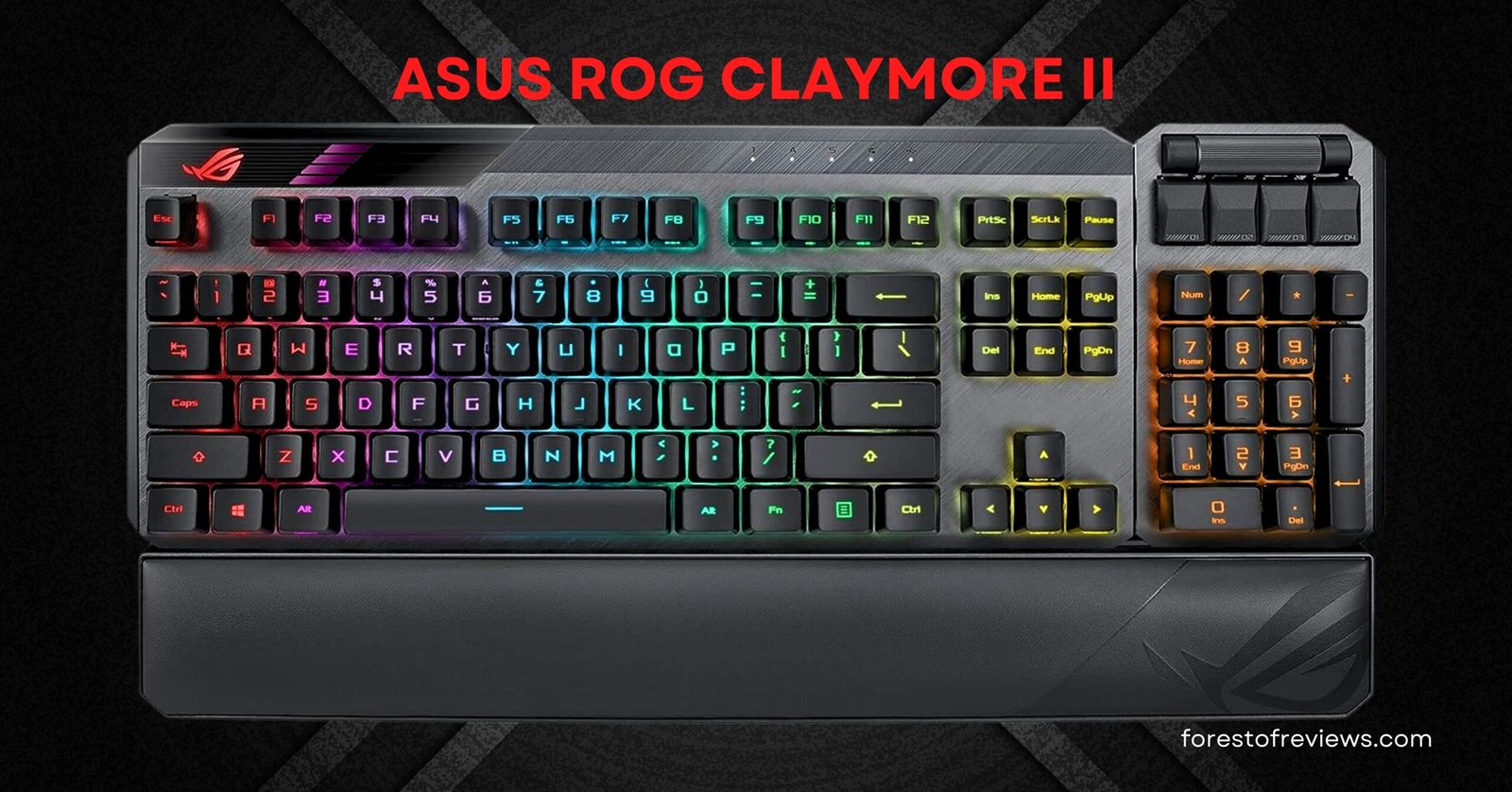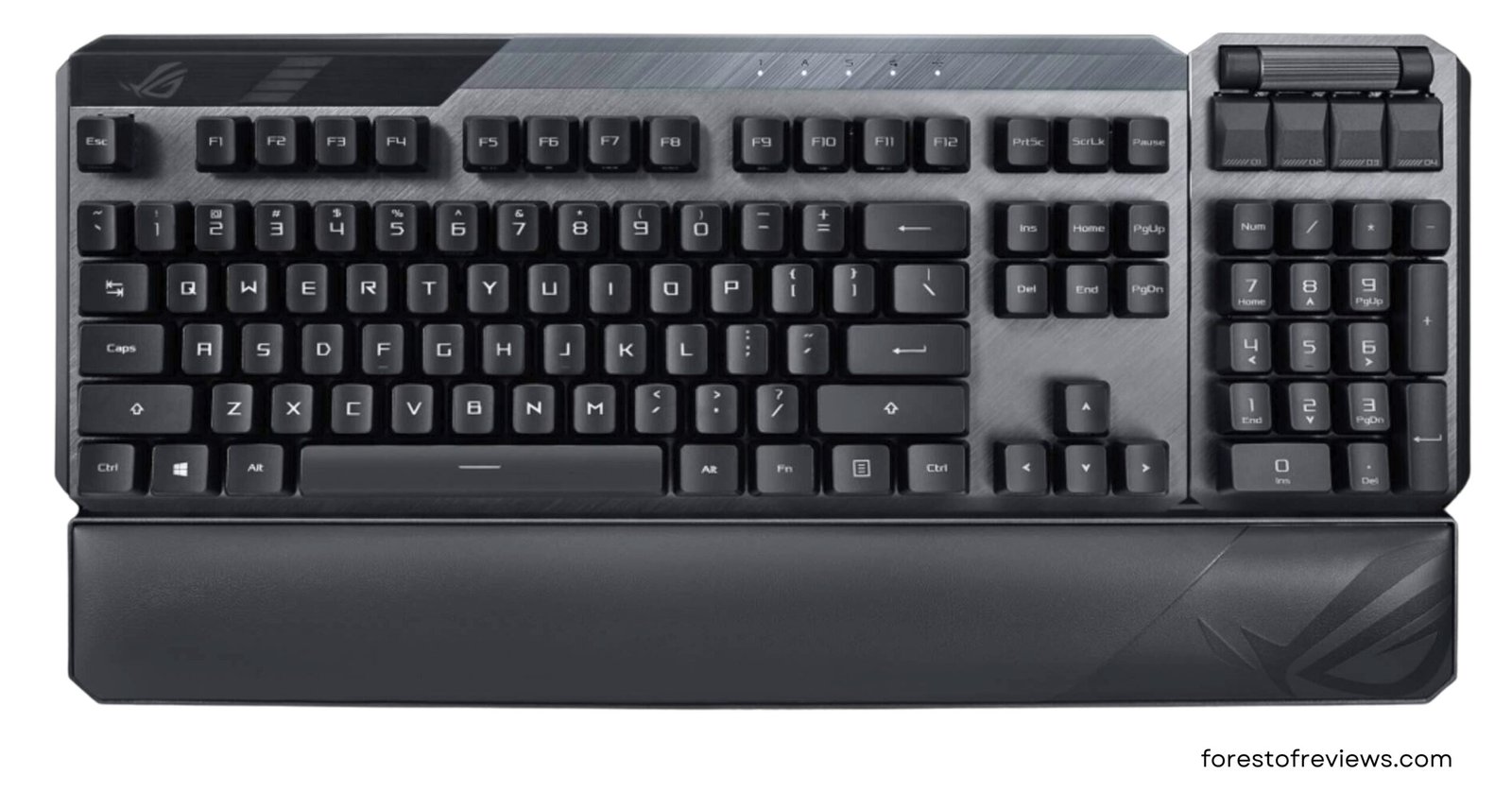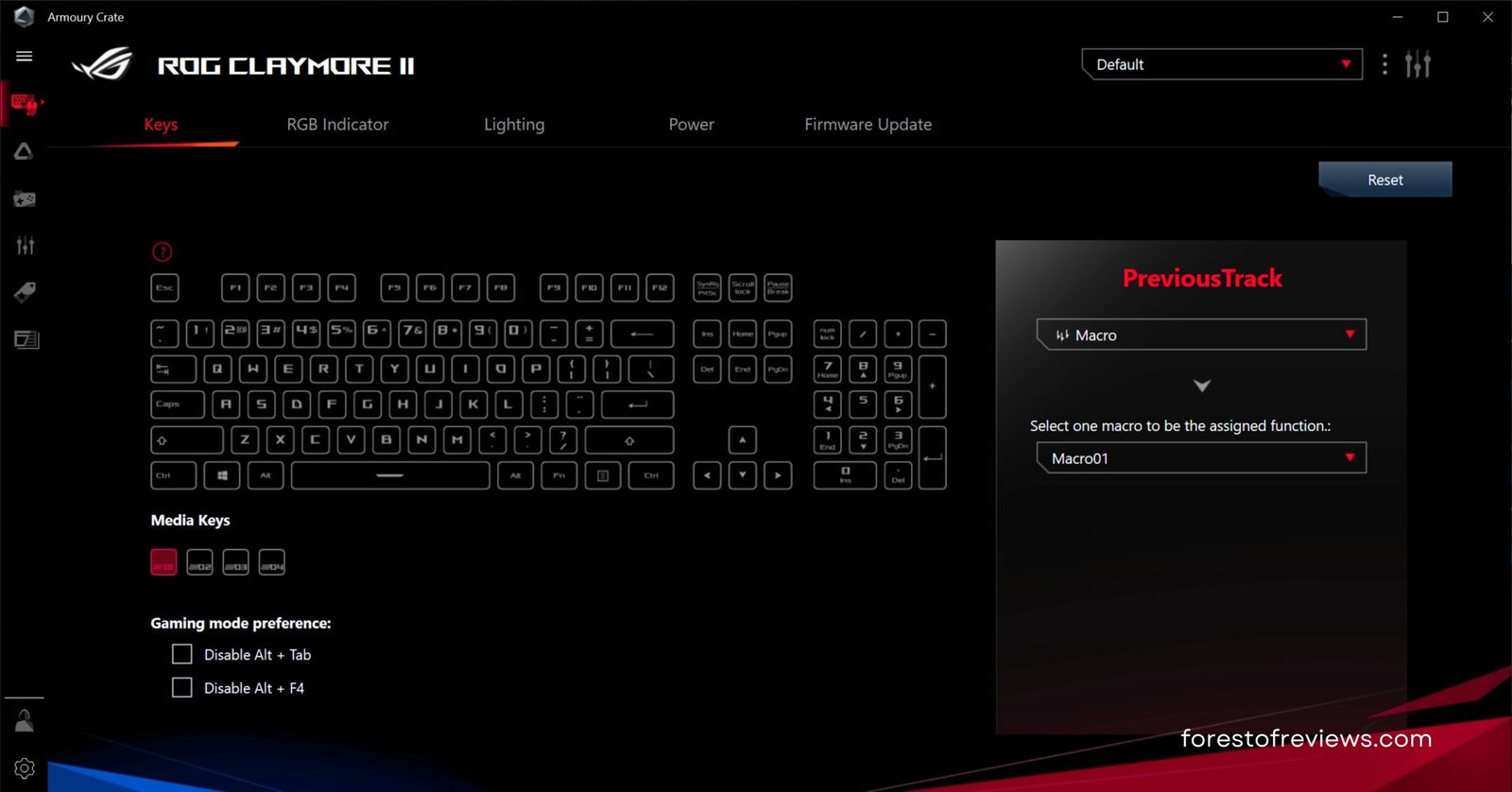If you’re in the market for a high-end wireless mechanical gaming keyboard that offers both style and functionality, the ASUS ROG Claymore II Wireless Gaming Mechanical Keyboard is a compelling choice. In this review, we’ll dive deep into the pros and cons, unique features, and overall performance of this keyboard. Whether you’re a left-handed gamer or simply seeking a top-tier gaming keyboard, the Claymore II could be your perfect match.
ASUS ROG Claymore II Specs
- ROG RX RED Optical Mechanical Switch
- USB 2.0 (TypeC to TypeA),RF 2.4GHz
- 4000 mAh battery
- Fast Charge & USB Passthrough
- Per-Key RGB LEDs
- PBT doubleshot keycaps
- 100% Anti-Ghosting
- All Keys Programmable
- On-Board Memory
- USB Report rate1000 Hz
- Armoury Crate
- Ergonomic Design
Pros & Cons
- Type-C to Type-C connectivity
- Modular design is ingenious
- Excellent optical switches
- Gorgeous aluminium finish
- Padded wrist pad
- Fast charging
- Flawless 2.4 GHz connectivity
- Very good battery life
- USB passthrough from a single Type-C cable
- Incredibly expensive
- Stock keycaps are laser-etched ABS
- Non-attachable wrist-rest
- Impossible to replace stock keycaps because of the practically proprietary design
ASUS ROG Claymore II
- ROG RX Optical Mechanical Switches
- Detachable Numpad
- Wired or Wireless 2.4 GHz RF mode
- FAST CHARGE OR USB PASSTHROUGH
- Wireless Aura Sync
- USB 2.0 Passthrough
Is It Worth the Investment?
The ASUS ROG Claymore II is undoubtedly a premium gaming keyboard with a price tag to match. At $203.79, it’s not a budget option. While there are other wireless mechanical gaming keyboards available for slightly less, the Claymore II stands out with its modular number pad and impressive features.
ROG Claymore II Body & Build
ASUS introduced the concept of a modular gamepad with the original Claymore in 2016, and it remains an exciting feature in the Claymore II. This keyboard takes things up a notch with proprietary optical switches, dedicated macro buttons, and wireless connectivity.
The ASUS ROG Claymore II itself is a tenkeyless (TKL) model with 87 keys, accompanied by a 17-key number pad that features four customizable buttons and a volume roller. A detachable wrist rest adds to the package. The two parts seamlessly blend, thanks to their matching shiny aluminum top plates and glossy black keycaps.
Comfortable Wrist Rest
The included leatherette-coated wrist rest attaches magnetically to the base of the keyboard. It’s well-padded and comfortable, providing wrist support during extended gaming sessions. While it’s a bit thin, it’s sufficient to keep your wrists elevated and comfortable.
Detachable Numpad
The advent of the Detachable Numpad by Asus in the original 2016 Claymore introduced a modular gamepad concept that continues to captivate in 2021. This enduring fascination may be attributed to the ROG Claymore II remarkable keyboard, which is nothing short of a marvel. Asus has left no stone unturned in this model, incorporating a plethora of features: novel proprietary optical switches, a dedicated macro button array in the conventional media key corner, and, to add the final flourish, wireless connectivity to your PC.
Technically speaking, the ASUS ROG Claymore II can be dissected into three distinct components: the core tenkeyless (TKL) keyboard, boasting 87 keys, a 17-key numerical pad replete with four customizable buttons and a volume roller, and a sleek yet luxuriously cushioned detachable wrist rest. The keyboard is the powerhouse, as the numerical pad doesn’t function autonomously. The wrist rest, although compatible with other keyboards, boasts a magnetic top edge designed to complement the Claymore II.
The advantages of having a detachable numerical pad are twofold. Primarily, it bestows left handed typists with the privilege of wielding the numerical pad with their dominant hand, expanding the accessibility of superior gaming peripherals to a broader audience. Another boon is that the complete removal of the numerical pad transforms the full-sized keyboard into a more portable TKL variant, occupying less real estate on your desk. With the numerical pad attached, the ASUS ROG Claymore II spans dimensions of 1.69 by 18.13 by 6.06 inches (HWD), but sans the numerical pad, it measures a mere 1.69 by 14.69 by 6.06 inches. This grants you the liberty to alternate between numerical pad functionality and a more compact footprint at your discretion.
ROG RX Opto Mechanical Switches
The ROG Claymore II boasts a distinctive hallmark in the form of its number pad, but its innovations go well beyond this singular feature. Foremost among these advancements is Asus’s departure from the conventional Cherry MX mechanical switches used in the original Claymore, in favor of their proprietary RX opto-mechanical switches. The unit we test was equipped with ROG RX Red switches, which exhibit a similarity to Cherry MX Silent Reds in terms of keypress ease. They yield with remarkable fluidity, devoid of any substantial resistance, albeit they lack the rapid-fire sensitivity associated with traditional Red style switches. While gamers who prefer the lightest actuation may not fully embrace them, I find them to offer a more harmonious experience, suitable for both typing and gameplay
The enduring optical-mechanical switches embedded within the ROG Claymore IIkeyboard promise a remarkable lifespan of 100 million keystrokes. It offers the choice between ROG RX Optical Mechanical Switches in either RX Blue or RX Red variants. The RX Blue version boasts a 65 gram actuation force, a slender 1.5mm actuation point, and a 4mm travel distance, while the RX Red version requires a gentler 45-gram actuation force, with the same 1.5mm actuation point and 4mm travel.
In a manner befitting the latest premium gaming keyboards, the ROG Claymore II employs optical-mechanical switches, albeit with a unique twist. These ROG RX optical switches employ an infrared configuration to monitor actuation, ensuring more precise tracking and extended durability compared to conventional switches. Yet, what truly sets these switches apart is their distinctive design. They feature a hollow square stem, further supported from below by an innovative x-stabilizer system, a metallic framework cradling the stem at its four corners, offering steadfast support to each keystroke.
ROG Claymore II Typing Quality
The ASUS ROG Claymore II delivers a satisfying typing experience. The ABS keycaps offer a slightly textured surface, enhancing keypress feedback. While these keycaps are comfortable, they are susceptible to finger oils, which may cause them to shine over time. The keyboard maintains stability across all keys, except for a slight wobble in the Spacebar. Thanks to the incline setting and the plushy wrist rest, typing fatigue is kept at bay. However, if you opt for the ROG RX Blue Optical Mechanical switches, be prepared for a bit of force required to actuate them. If you prefer a lighter touch, the ROG RX Red Optical Mechanical switches are also available.
RGB Lightings
An additional highlight of these switches is their unique LED placement for RGB lighting. Nestled within the core of the keyswitch, the LED illuminates the keycap from within,
ensuring an unobstructed and vibrant display of lighting effects. The Claymore II offers per-key illumination, with compatibility for both Aura Sync and Aura Creator. Within the
Armoury Crate software, an array of RGB lighting effects awaits your selection, including static displays, breathing patterns, color cycling, a mesmerizing rainbow spectrum, and even a
starry night theme. Notably, the reactive lighting effects, where illumination emanates from each keypress, particularly stand out as crowd-pleasers.
ROG Claymore II Connectivity
The Claymore II is part of the growing trend of wireless mechanical gaming keyboards. It connects wirelessly via a 2.4GHz USB dongle, and the wireless performance is flawless. The keyboard features USB passthrough, although it only works when the keyboard is connected via wire. While this might be a limitation, it’s still a valuable addition for those who need extra USB ports.
Charging & Battery Life
Charging the 4000 milliampere-hour (mAh) battery typically becomes an overnight endeavor due to the constraints of the USB 2.0 interface, which offers a mere 0.5 amperes (A) compared to the 1.5 A available through the same 5-volt line using USB-C. Furthermore, the presence of an extra USB port, sans a passthrough cable for connecting peripherals like a mouse, is a noteworthy addition. ASUS ROG Claymore II lays claim to a battery endurance of up to 144 hours in full-size mode with the lighting deactivated, and up to 43 hours with the lighting activated, all while cunningly omitting any specifics about the brightness or lighting effects. In practicality, my tests indicate a usage time of just under 30 hours with a static lighting effect at 100% brightness.
Replenishing the battery is a fairly straightforward task, and there’s no reason for guilt associated with it, primarily because the wireless mode operates so seamlessly. ASUS has thoughtfully provided a method to extend the wireless dongle, although I personally had no need for such an extension. The 2.4 gigahertz (GHz) dongle is quite diminutive and convenient for stashing away, and it exhibits no discernible latency or interruption during use. Operating the keyboard wirelessly does, of course, preclude the use of the USB port for other peripherals, but this is hardly surprising.
ROG Claymore II Armoury Crate
Configuring the Asus ROG Claymore II through ASUS’s Armoury Crate software was a straightforward and hassle-free experience. The software offers a wide range of RGB lighting options, including pre-programmed effects like breathing and responsive keypress lighting. It also allows synchronization with other ASUS RGB products. A notable feature is the ability to check the keyboard’s battery percentage while the software is minimized, offering added convenience.
The ASUS ROG Claymore II is fully compatible with Windows. It partially works with macOS and Linux, but note that the Scroll Lock and Pause keys may not function on macOS. Unfortunately, this keyboard is not designed for mobile devices.
Final Virdicts
In conclusion, the ASUS ROG Claymore II is a formidable gaming keyboard that offers a unique modular design, superb build quality, and an array of customization options. It excels in the gaming world with low latency, macro-programmable keys, and an eye-catching RGB backlight. The only caveat is that the ROG RX Blue Optical Mechanical switches may feel heavy for extended typing. However, with the alternative ROG RX Red Optical Mechanical switches, this concern is alleviated. If you’re on the quest for a gaming keyboard that adapts to your needs, the ASUS ROG Claymore II is undoubtedly worth a look.
FAQS
Is ROG Claymore 2 red or blue?
The Claymore II has a choice of ROG RX Red or RX Blue switches. Gamers will likely want to choose the Red switches as they actuate with less pressure and will be more satisfying (and quieter) for gaming.
Is the ASUS ROG Claymore II suitable for office use?
The clicky ROG RX Blue Optical Mechanical switches may be too noisy for a quiet office setting. Consider the ROG RX Red Optical Mechanical switches for a quieter experience.
How long does the battery last when using the ASUS ROG Claymore II wirelessly?
ASUS claims the battery lasts 144 hours without backlighting and 43 hours with 100% brightness, but this wasn’t tested in our review.
Is the modular numpad on the ASUS ROG Claymore II detachable?
Yes, the numpad is modular and can be attached to the left, right, or completely removed to transform the keyboard into a TKL layout.
Is there any mobile device compatibility with the ASUS ROG Claymore II?
No, the keyboard is not designed for use with mobile devices; it can only be used with its USB receiver.



















